Emperor: Battle for Dune Preview
Westwood's next RTS game will be in full 3D, and we've got the scoop.
For more than 15 years, Westwood Studios has been designing and developing games that span nearly the entire spectrum of traditional PC genres. But though the Las Vegas-based developer has released numerous role-playing, adventure, and action games in the past, Westwood is most popular for its successful line of strategy games, more specifically, the Command & Conquer series. Released in 1995, Command & Conquer defined the dynamics of real-time strategy gaming, and even to this day the game continues to influence recent RTS games. But as popular as the game was (and continues to be), few know that it was Westwood's Dune II that laid the groundwork for Command & Conquer. Originally released for the PC in 1992, Dune II was Westwood's attempt at popularizing the relatively small wargame genre by making a game that incorporated new gameplay ideas and yet was still accessible to a broad range of users. Westwood succeeded, and the result was the game widely acknowledged as the pioneer of the real-time strategy genre as we know it today. Now, nearly eight years later, Westwood is steeped in the development of the true sequel to Dune II, Emperor: Battle for Dune.
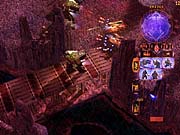
Emperor: Battle for Dune represents Westwood's foray into the world of the 3D real-time strategy genre. For some time, developers have been using 3D technology to design their RTS games, and Westwood critics have been vocal about the company's decision to stay mired in 2D. And while the company's recently announced action game, Command & Conquer: Renegade, makes full use of 3D technology, Westwood's venerable line of strategy games have retained aging 2D tile-based systems... until now. Westwood will officially announce Emperor: Battle for Dune later this week, but we were invited to take a firsthand look at this strategy game before its unveiling. We first saw the game a few months ago, although at the time, it was nothing more than a technology demonstration. During a more recent trip to the Westwood offices, we could clearly see the progress made by the development team on Emperor: Battle for Dune. Westwood's first 3D real-time strategy game is coming along nicely.

Westwood asserts that the game will have all the benefits of a 3D real-time strategy game while retaining the accessibility of Command & Conquer or Red Alert 2. But Emperor: Battle for Dune is more than just a 3D version of Command & Conquer. Like Electronic Arts' Shogun: Total War, Emperor: Battle for Dune will feature a strategic layer where you'll be able to manage your forces on a much broader level before diving into each battle. You'll also be able to choose from eight different factions, fight on four completely unique worlds, and play through the entire campaign online. It's certainly an ambitious feat, and we're the first with the in-depth info. Let's take a look at Emperor: Battle for Dune.
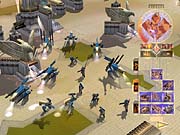
The Story
Emperor: Battle for Dune takes place in the same Dune universe originally created by Frank Herbert and then later popularized by David Lynch's 1984 movie. The world of Dune is governed by aristocratic houses that rule their empires through the use of either force and fear or just ways and virtue. These political units have little in common with one another, except for the undying desire to control the planet of Arrakis, more commonly referred to simply as Dune. Arrakis gets its nickname from its barren deserts and endless dunes of sand - a dead planet forever trapped underneath a blazing sky. But Arrakis holds a treasure coveted by the entire universe: a spice called melange. Melange is an extremely addictive drug that grants its users not only infinite wisdom and a prolonged life span but also the ability to fold the fabric of the universe, making interstellar travel possible. Needless to say, the house that controls the flow of melange controls the universe. In the past, Emperor Fredrick IV and his ruling house held control of Arrakis and granted mining rights to the various other houses as he saw fit. More often than not, he'd use his lofty position to play these houses against each other, causing skirmishes and political assassinations that would weaken his enemies and make him and his ruling family stronger. But now, in the year 10190, the emperor is dead, and all the houses of the universe are vying for their stake of Arrakis and the emperor's throne. Emperor: Battle for Dune will thrust you in the midst of this world of deceit, treachery, and all-out war.
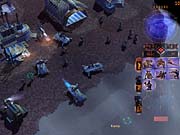
There are three playable factions in the game: the House Atreides, the House Harkonnen, and the House Ordos. Fans of Herbert's novels will instantly recognize the first two factions, as the Atreides and Harkonnen houses play prominent roles in the fiction. The third house, Ordos, is an obscure faction that has been previously mentioned in Ace Publishing's Dune Encyclopedia. Your role will be that of a field commander for one of these three houses, and it'll be your goal to overtake Arrakis, lead your empire to total victory, control the flow of spice, and instate an emperor to rule the universe. Like in previous Westwood strategy games, you'll choose one of these factions from the outset to finish the entire campaign with. Once you've completed the game, you can then go back and play as either of the two remaining factions. Additionally, you'll be able to ally yourself with five other factions, or subhouses, at any time during the game. Also part of the original Dune fiction, these smaller factions include House Ix, the Fremen, the Sardaukar, the Guild, and House Tleilaxu. When you ally with one of these five smaller houses, you'll be privy to their personal technology and unique array of units, giving you a number of different ways to customize your primary faction.
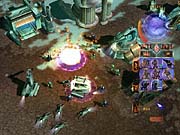
The Ruling Houses
Each of three major factions in Emperor: Battle for Dune is composed of 15 to 20 unique units and structures that aren't replicated from house to house. The three houses in the game share only their construction yard, harvester, and basic infantry unit. Additionally, you'll be able to ally yourself with up to two of the five subhouses in the game at any time during your campaign. Doing so will grant you access to each of the subhouses' list of units, giving you an additional five vehicles or structures per alliance. This gives Emperor: Battle for Dune lots of replay value, as you can create a different combination of houses and subhouses each time you play. While Westwood hasn't finalized the game's entire list of units, below is the basic rundown of each of the three major houses and five lesser houses that'll be found in Emperor: Battle for Dune.
House Atreides: Unlike the other houses in the Dune universe, House Atreides employs just methods to rule over its homeworld of Caladan. Noble in spirit, the Atreides have developed a form of government that promotes the well-being of its society and stresses the importance of culture and spirituality. These living conditions have inspired the empire's people to be fiercely loyal toward the House Atreides. This same loyalty extends to the house's armies, making them one of the deadliest forces in the universe.
Within the game, the units and structures of House Atreides have a very Mayan look to them. The Atreides' crest of a hawk is emblazoned on nearly everything from the barracks to the flying ornithopter, and it's even used as part of the Atreides' superweapon, the hawk strike. Generated by the Atreides palace, this weapon emits a subsonic pulse and a holographic projection of a massive hawk that sends enemy troops scurrying away in fear and then temporarily paralyzes them.
House Harkonnen: The House Harkonnen rules its empire with an iron first. Soldiers who fail to perform on the battlefield will suffer a slow death at the hands of the Baron Harkonnen upon their return home. Promotions are gained through deceit, treachery, and assassination.
In Emperor: Battle for Dune, the Harkonnen occupy Giedi Prime, a postindustrial world devastated by refuse, toxic waste, and overpopulation. Their units reflect their culture and feature some of the most wicked-looking vehicles and structures in the game. This is typified by the Harkonnen buzzsaw, a lightning-fast unit that not only chews up any infantry in its way but can also destroy fields of spice, thus preventing other factions from harvesting the necessary resource. Their superweapon is a deadly atomic blast that incinerates everything within its blast.
House Ordos: An obscure part of the Dune universe, House Ordos are a mysterious people whose world of Sigma Draconis is covered with ice. This house has no apparent leader, as only a small group of secretive cartel members seem to rule the vast majority of the empire. They specialize in the smuggling of weapons, and next to House Ix, they are the primary suppliers of arms to the different houses of the universe. Ordos troops are paid handsomely; however, their armies suffer from a very high desertion rate.
The Ordos units are very cold and plain in their appearance, and they consist of tanks, hovercrafts, and even mech-like walkers. One of their more standard units, the kobra cannon, behaves like a normal tank but can also be deployed into an artillery cannon, which makes it less mobile but a lot more powerful. Their superweapon emits a gigantic bolt of electricity that can devastate any unit or vehicle that it strikes.
Subhouses
House Ix: Fascist arms dealers, the Ix will ally with anyone who can afford their "friendship." They prefer not to do any of the actual fighting themselves, as the Ix see themselves above such petty differences. They wish only to profit from the war.
The Fremen: The Fremen are original inhabitants of Arrakis who've been turned into powerful warriors after enduring life on the harsh desert planet. They hold the roaming sand worms of Arrakis to be deities and build secret underground oases in hopes of making the entire planet more hospitable to life.
The Sardaukar: Once personal shocktroopers of the late emperor, the Sardaukar are warriors who've been hardened by the desolate environments of their planet. They respect the Fremen, although they still consider the Arrakis inhabitants to be foes.
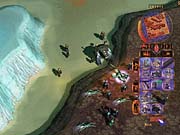
The Guild: The Guild have mastered interstellar travel through the development of navigators, humans who've been soaked in melange gas. They will ferry any of the houses throughout the universe for a small fee.
House Tleilaxu: The Tleilaxu shun technology and revel in the practice of cloning and reanimating the dead. These peoples are looked down upon by all the other houses in the universe, but they're secretly conspiring with The Guild.
Many of their units look like the Zerg from Starcraft, and one particular creature we saw had the ability to transform any unit it killed into another such creature. This has a devastating effect in practice and can turn the tide of a battle instantly.
New Layers of Strategy
Real-time strategy games have always stressed tactical gameplay over actual strategy. And while Blizzard is attempting to integrate common RTS dynamics with role-playing elements in Warcraft III, Westwood is heading in a different direction and will be adding a new layer of strategy to a genre that's largely been focused on tactics. This addition will come in the form of the planetary level interface. Before jumping into a mission, you'll be taken to an overhead map of Arrakis that's divided into color-coded regions. Each colored region symbolizes a territory occupied by one of the three houses in the game. From this screen, you'll be able to access your main forces, denoted by a round icon, and your two reserve forces, which are represented by a stick-figure icon. Your goal is to successfully invade and take over both of your enemy's jumpgates on Arrakis that lead back to their respective homeworlds. How you do so will be entirely up to you. You're only allowed one move per turn, but from this screen, you can order your forces to attack or retreat, you can resupply your main front, you can use your reserves or keep them on hold for a later date, you can flank and surround a territory, and so on.
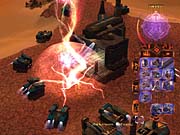
Every move affects nearby territories, and you can receive information, like troop movement and worm activity, relevant to that block of land by simply highlighting it with your mouse pointer. You can then decide if it's viable to move your troops into that area, or if you should wait for circumstances to be more favorable. After you decide on a course of action, you'll be thrust into real-time combat, and depending on the outcome of your mission, the strategic map will have changed accordingly. Additionally, each block of territory is a randomly generated mission. So while the objective of a given mission might be to stock up on melange the first time, it could be something completely different the next time you play that mission.
Once you enter a mission, you'll find a world that's completely rendered with 3D polygons. The game's robust new 3D engine will give you the ability to zoom in and out of the world, rotate around any area or unit, and adjust the angle of the camera's pitch. While it may seem complex, these camera functions are a breeze to manipulate, and they don't involve anything more than scrolling your mousewheel and depressing the right mouse button. Individual units are made up of a high number of polygons and have an assortment of walking, attacking, and idle animations. Additionally, each unit and structure throws its own shadow onto the environment, and effects like explosions and spotlights produce dynamic lighting effects that add a sense of visual realism to the game. This engine and other parts of the game are being codeveloped by Westwood and Intelligent Games in London, the same company that worked on 1998's Dune 2000. Although a final list of features isn't ready yet, Westwood claims that the game's 3D engine will support a wide suite of popular technologies and APIs.
Final Thoughts
Arguably the best part of Emperor: Battle for Dune will be the control interface, the same aspect of Command & Conquer that drew praise for its intuitive layout and ease of use. While the game will be in full 3D, the control scheme of Emperor: Battle for Dune follows the classic Westwood-style interface. Most of your building options are located on the right-hand side, with a 3D radar map in the upper right-hand side. This map looks like a stylized, hand-drawn representation of your surroundings, but it is in fact modeled in 3D, and it will mimic the rotation of your main camera. Tabs for infantry, vehicles, and structures are located on the left side of the build list instead of on top, which is the more traditional location for them. The two tabs located on top of the build list are used to order upgrades to your structures and to request units through the starport. Starports are glorified transporters that beam down any unit that you normally have access to, the only difference being that you receive them immediately and don't have to wait for their build cycle to complete. However, units ordered through the starport are more expensive than those built in the traditional way. Structures will be modular and can be upgraded for added efficiency. For example, the refineries have two additional ports that you can attach ramps to, which give your harvesters the ability to unload their spice at once, without having to wait in line.
The last four iconic tabs appear above the structure upgrade and starport buttons. These are used to sell structures, to repair structures, to order your units to guard a specific object or area, and to order a retreat. Like in Command & Conquer, you can lay down numerous waypoints for your units to follow, you can lump unit types into a group, and you can set rally points from any structure that produces vehicles. The build we played didn't have control functions for assigning formations, but the final version of Emperor: Battle for Dune will have that feature incorporated. Lastly, the final part of the interface, the money counter, is located in the extreme upper right-hand corner of the screen, on top of the radar map.
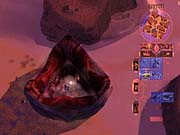
The only resource in the game is the melange spice, which is denoted on the ground by telltale orange patches. While managing only one resource will make the game relatively easy, it's interesting to note that all the spice is located on the sand dunes of Arrakis and not on the rock outcroppings. Dune fans know that the sand is home to the giant worms that are attracted to vibration, and they'll swoop up out of the ground to swallow any poor souls caught unaware. The game will have three worm types, essentially small, medium, and large, and if you ally with the Fremen, you'll be able to summon and ride some of them.
In all, the game will be split up into 33 territories that draw from a pool of more than 100 randomly generated missions. The storyline will be carried out through a mix of live-action footage and prerendered animation, as is typical of most Westwood games. As of now, actors who have signed on to play key roles in Emperor: Battle for Dune include Star Trek's Michael Dorn, Michael McShane from Drop Dead Gorgeous, Vincent Schiavelli from Fast Times at Ridgemont High, and The Cell's Lucita Vander.
In addition to its single-player component, Emperor: Battle for Dune will include two multiplayer modes: a standard skirmish mode and an ambitious multiplayer campaign mode. In this latter mode, up to three players can go through the entire campaign over either a LAN or Internet connection. The person who starts the campaign will be the only one who can save the game's progress - the other players can then rejoin the game and continue the campaign at a later time. As it stands now, the game will be able to run on a 266MHz Pentium II, but that system requirement might crawl up to a Pentium III, and it will support resolutions as high as 1600x1200.
Westwood is clearly trying to progress the genre that it perfected by incorporating a number of new features into its latest real-time strategy game. While some of these, like the use of a 3D engine, are new only to Westwood, others, like the strategic overview map, are features that are almost brand new to the RTS genre. The game makes a great first impression, and it'll be interesting to see how well Westwood integrates this new 3D technology with its accessible style of play. Emperor: Battle for Dune is scheduled for release in mid-2001, but we'll update you with more information before then. Stay tuned.
Got a news tip or want to contact us directly? Email news@gamespot.com
Join the conversation